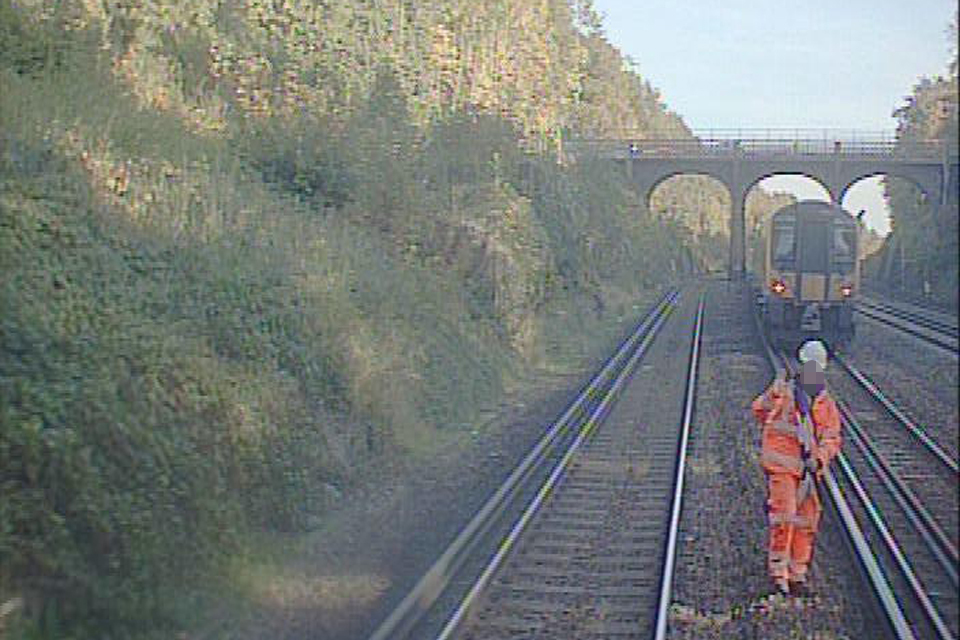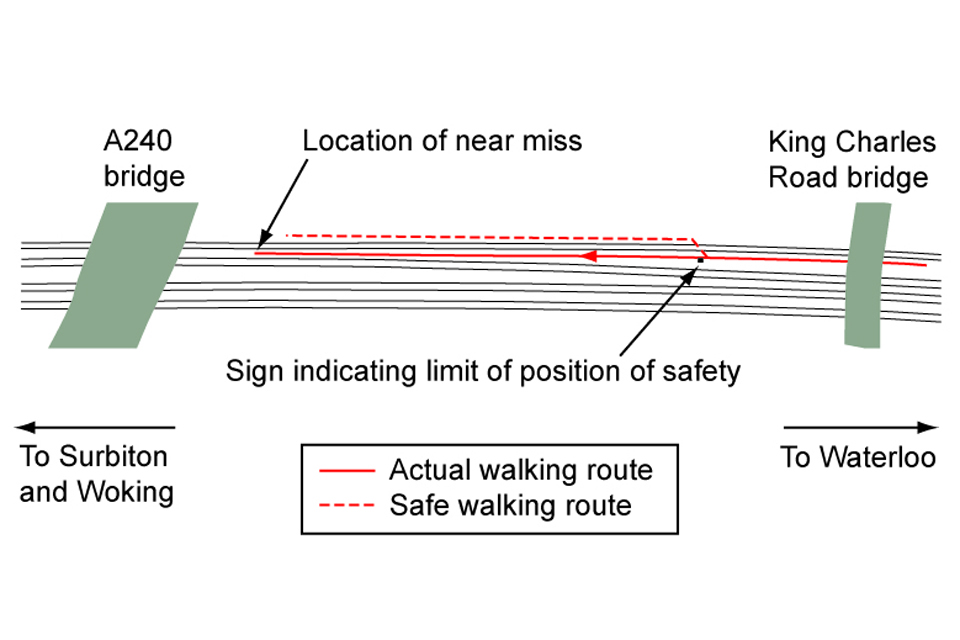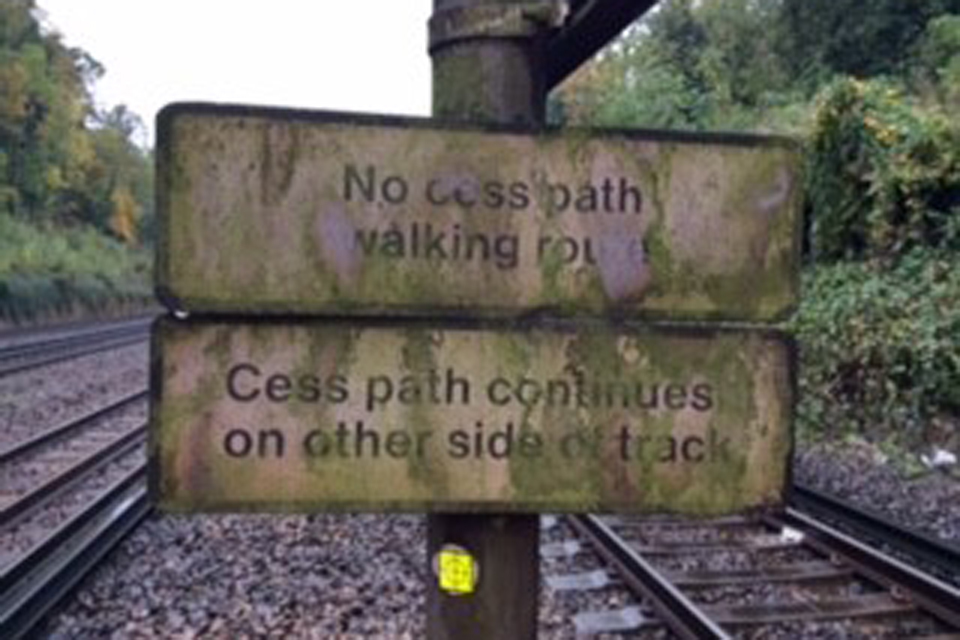Near miss at Surbiton, south-west London, 2 November 2016
Published 6 March 2017
1. Important safety messages
This incident highlights the importance of:
- making sure that the arrangements for ensuring the safety of a workgroup, including the positions of safety, are clearly understood before going on or near the line; this is especially important when the workgroup is moving along the line and/or where staff are unfamiliar with the location
- making sure that staff with safety critical roles on site, including lookouts, are familiar with the location
- always remembering that the space between two lines (the ‘six foot’) is a dangerous place to stand or walk
2. Summary of the incident
At 10:32 hrs on Wednesday 2 November 2016, a track worker narrowly avoided being struck when he was caught between two trains that were travelling in the same direction on adjacent lines. There was an interval of less than two seconds after the passage of the first train before the arrival of the second train; this allowed the track worker to take evasive action. He was unhurt in the incident.

Still image from forward facing CCTV image from the second train, looking away from Surbiton, showing the rear of the first train (courtesy South West Trains)
The first train, the 07:55 hrs Weymouth to Waterloo service, was travelling on the up fast line at close to the maximum permitted speed of 80 mph (129 km/h). The track worker was standing between the up fast and up slow lines as this train passed him, in the space usually known as the ‘six foot’. The second train, the 10:24 hrs Hampton Court to Waterloo service, had travelled approximately 350 metres after its departure from Surbiton station on the up slow line when the driver saw the track worker in the six foot ahead of him. This train reached the track worker less than ten seconds after the first train. The driver of the second train applied the brake and reduced the speed of the train from approximately 33 to 24 mph (53 to 39 km/h). He subsequently reported that a near miss had taken place with a track worker.

Schematic diagram of track layout showing the four lines between Surbiton and Berrylands stations. The location of the trackworker is highlighted by an arrow.
In situations when it is not possible to get to a position of safety (at least 1.25 metres from the nearest line), staff are advised during their training to lie down, but not in the ‘four foot’ (in between the rails of any line). However, there was a live 750 V DC conductor rail in the six foot and the track worker did not lie down there. While he was moving out of the path of the second train he raised his hand to acknowledge its presence.
3. Cause of the incident
The track worker was part of a routine patrol to inspect the condition of the track; this was being carried out by an acting team leader who was also the controller of site safety (COSS) for the work. It had been planned using a safe system of work using unassisted lookout warning (ie the work was being carried out while trains were running), and required a distant lookout as well as a site lookout due to restricted sighting near Surbiton. The COSS had carried out the same patrol many times before and had previously been accompanied by lookouts who were familiar with the location. On this occasion, due to resource shortage, he had selected two members of agency staff as lookouts. The track worker involved in the incident was acting as the distant lookout, providing early warning of approaching trains to the other two members of the workgroup; he was not experienced in working at the specific location. The COSS had instructed the track worker to walk approximately 200 metres ahead of him and the site lookout as they walked along the up lines towards Surbiton.
Where the railway passes underneath the King Charles Road bridge, the six foot is described as a ‘wideway’ because it is wide enough to provide a position of safety. The wideway narrows to a conventional six foot before the bridge carrying the A240 road over the railway.

Track layout showing the walking route taken by the track worker as opposed to the safe walking route he should have taken.
The COSS expected that when the track worker reached the limit of the position of safety, due to narrowing of the wideway, he would cross the up slow line and continue to walk along the up cess (the space alongside the up slow line). Although there is a sign denoting the limit of the position of safety in the wideway, the COSS had not told the track worker that he would have to cross over to the cess. When the track worker reached the sign, which was in poor condition and referred to a ‘cess path’ despite being situated in the wideway, he continued walking along the six foot towards Surbiton. The track worker was therefore not in a position of safety when he saw a train approaching him on the up fast line. After signalling the approach of the train to the site lookout, he then became aware that a train was also approaching him on the up slow line.

Photograph taken after the incident, showing the sign indicating the limit of the position of safety in the wideway (courtesy Network Rail)
The incident resulted from a combination of the track worker’s unfamiliarity with the area and an apparent lack of awareness of the risk he was taking. The incomplete briefing from the COSS, which did not adequately explain that the position of safety would move from the wideway to the cess after passing under the King Charles Road bridge, was also a factor.
4. Previous similar occurrences
RAIB has previously investigated a number of accidents and incidents involving track workers, and is shortly due to publish a report into an investigation into the safety of track workers outside possessions. Accidents with similarities to the near miss at Surbiton include:
- Leatherhead, 29 August 2007 (RAIB report 19/2008). During track patrolling (inspection) work, a track worker was struck and injured by a train that was travelling at about 25 mph (40 km/h). He had remained in the space between adjacent lines as trains approached on both lines.
- Dalston Junction, 30 March 2009 (RAIB report 30/2009). A lookout was struck and injured by a train travelling at about 15 mph (25 km/h). The lookout was not familiar with the area. During the work, the COSS and the lookout did not maintain close communication with each other, and the lookout was about 150 metres ahead of the rest of the group.
You can print this safety digest.

